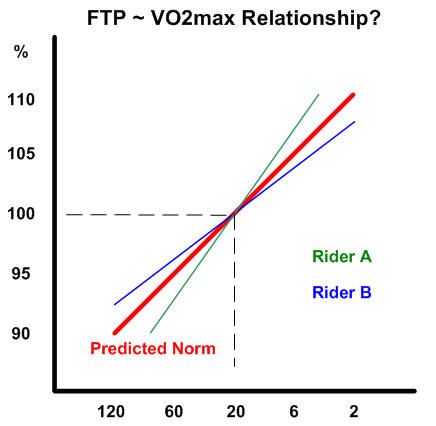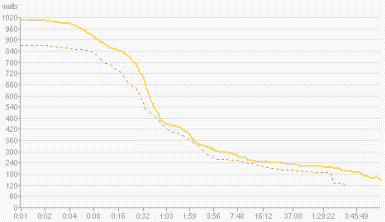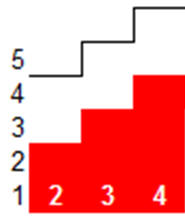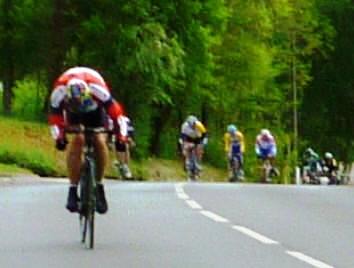FAQ ~ FTP VO2max Relationship

A "theoretical" predictor of FTP & VO2max
from a 20 minute Performance Evaluation
I have done the FTP sessions reasonably comfortably on the numbers but I am struggling with the Suffervals Pro drill. I can manage the first two blocks but on the third I get about 2 minutes in then run out of steam and back off a bit down to FTP for the last two minutes. Same happens on the fourth.
Alan Lloyd ~ UK
A great question which opens up a whole can of worms! Because we just don't all fit the nice performance charts that are designed for us by the sport scientists. But to be fair, they all tell us that, so we shouldn't really be surprised!
Scores On the Doors...
The red line in the chart above shows the
theoretical relationship between a wVO2max 6 minute interval,
a 20 minute FTP Test and FTP itself. All this is explained in
greater detail right here...
Effectively, if you undertake a 20 minute test and have this as your reference 100%, you can go 5% harder for six minutes, but go 5% less hard for sixty mintues. That's the theory.
But if you're not measuring FTP, VO2max or your EFR 20 minute pace directly, then you are exposing yourself to variances and margins for error.
Using a percentage of a tested power output, to give you a theoretical percentage, of a constantly dynamic, physiological variable, is asking for trouble and a random outcome. Which is why we stress many, many times in our programmes that you ride to your ability, not the numbers.
To undertake our Suffervals Pro session correctly, would require you to run three different tests before doing so, or consult your software's current Mean Maximal Power curve.
Not everyone has power, so you must ride on feel. And feel is by far the best way of "surviving" this session.

WKO+ Mean Maximal Power Curve (monthly
comparison)
You can see how it changes throughout the season
The
Session In Question
 A
Suffervals Pro Interval requires you to ride for...
A
Suffervals Pro Interval requires you to ride for...
Two minutes @ FTP (60 min) Pace
Three minutes @ EFR (20 min) Pace
Four minutes @ wVO2max (6 min) Pace
Theoretically, how hard can that be? Not very, is the answer.
But in reality, it's a whole different ball game. Three physiological responses hit in just one interval effort! If it was easy, it wouldn't be in our programmes.
Theory v Practice
Okay, there are probably some riders, at some point in the year,
that fit the perfect red line above. Their FTP is 5% below
their 20 minute pace and their wVO2max is 5% above it.
Some will better follow the green line, and some will track the blue line. Meanwhile, there will be others that fit the lower blue line and upper green line, or lower blue and upper red, etc. Or all combinations of red, green, blue variations thereof!
That's the beauty of working with humans, not machines. If there's a variance out there to be found, we'll find it.
And of course, all these percentage variations will change throughout the year as your fitness changes and your mechanical, as well as aerobic, efficiency increases or decreases. Things never remain the same.
Your ability to "hit the numbers" (at any time) depends on mitochondria density, blood oxygen saturation, fast/slow twitch muscle fibre ratio, muscle capillarization, glycogen levels, hydration, residual fatigue, plasma volumes, cardiac output, lactate tolerance, as you can see I can go on, and on, and on...
The Answer?
All you can do is all you can do. The objective of all our
sessions is that you "just" get to the end of the session. If
you can, you've done it right. If you can't you've gone too
hard.
Personally, I ride 99% of all my sessions blind. I have no idea what power I'm putting out until I download it and analyse it at the end. I go as hard as I believe I can, for the duration prescribed, to get to the end.
When I finish, I know I couldn't of given any more. So it doesn't really matter what the numbers say. It is what it is. If it isn't enough, then I keep going until it is.
I don't always get it right. But I have a very, very keen sense of exactly how hard I can pace myself for how long. It's important to know this if you try to start a break, jump a gap to a break that's up the road, or just a simple attack in the final kilometre.

attacking in the final kilometre for
sixth in the Ble D'Or sportive
having missed the break earlier in the race!
Testing Testing
There are many ways of testing for FTP
and VO2max, but generally, there are
three "steady-state" tests that are used the most. All should be ridden
smoothly, so pacing is as important as the final numbers.
A 60 minute effort,
with nothing left in the tank at 59:59. This one hurts a lot,
and is the most accurate. ~ 25 mile TT?
A 20 minute effort,
with nothing left in the tank at 19:59. This one hurts a lot,
but for less time, and gives a "predicted figure" of 105% of the 60
minute effort. ~ 10 mile TT?
A 6 minute effort,
with nothing left in the tank at 5:59. This one is a stinger,
but obviously is over quicker! It gives a "predicted
figure" of 105% of the 20 minute effort.
30 second video taken at five minutes in, with one minute to go
Dr Richard Worth giving it 100% ~ Filmed in Painorama
Pros & Cons
Who has the time, energy or mental capacity to routinely test for 60
minutes at a time? I'd suggest, not a lot of people these
days. Also, the residual fatigue from this test could last a
week. Preventing further development. However, if ridden
correctly, it is 100% accurate.
The 20 minute test is much more physically and mentally manageable. Residual fatigue is a fraction of the 60 minute test and it is within the capacity of us all to do this once a month. It's pretty much accurate as the effort is long enough to challenge the cardiovascular system.
The 6 minute test is the least accurate, but most accessible. We can all manage a six minute effort. Residual fatigue is minimal, but the "preparation protocol" is often flawed, because it requires the nullification of the neuro-muscular system.
Most never do this, for time or ego reasons, so the effort here is often heavily skewed towards muscle power rather than oxygen delivery power. On the road, many people do this session on a hill, which also massively skews the figures.
The 6 minute test often over estimates FTP when compared to the 20 minute test. So whichever test you do, make sure you are consistent.
Please Note ~ You can also do a Ramp Test, and take your final 60 second power output and multiply that by around 75% to get your FTP figure, but again, this is just a calculation. It's also, not steady-state!








